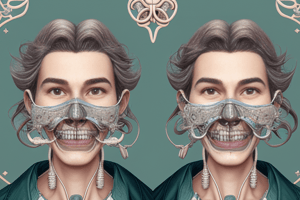Podcast
Questions and Answers
What is one of the aims of orthodontic treatments?
What is one of the aims of orthodontic treatments?
- Improving the efficiency of the stomatognathic system (correct)
- Displacing the condyles in their fossa
- Increasing the strain of musculature
- Reducing the number of teeth in the mouth
What does 'structural balance' refer to in orthodontic treatments?
What does 'structural balance' refer to in orthodontic treatments?
- Causing imbalance in the skeletal structures
- Ignoring the surrounding soft tissue envelop
- Maintaining a balance between teeth and surrounding structures (correct)
- Prioritizing the correction of teeth over other structures
What is the definition of 'occlusion' in orthodontics?
What is the definition of 'occlusion' in orthodontics?
- The relation of maxillary and mandibular teeth when jaws are closed without strain or displacement (correct)
- The displacement of maxillary and mandibular teeth when jaws are closed
- The alignment of certain teeth without regard for jaw position
- The movement of condyles in their fossa during jaw closure
What is an 'ideal occlusion' in orthodontics?
What is an 'ideal occlusion' in orthodontics?
What is the role of orthodontic treatments in relation to esthetic demand?
What is the role of orthodontic treatments in relation to esthetic demand?
What should orthodontic treatment maintain with regard to the affected structures?
What should orthodontic treatment maintain with regard to the affected structures?
What is the defining characteristic of an ideal occlusion?
What is the defining characteristic of an ideal occlusion?
Which type of malocclusion involves abnormal relationship between two teeth or groups of teeth of one arch to the other?
Which type of malocclusion involves abnormal relationship between two teeth or groups of teeth of one arch to the other?
What did Edward H. Angle base his classification of malocclusion on?
What did Edward H. Angle base his classification of malocclusion on?
What is the defining characteristic of Class II malocclusion according to Angle's classification?
What is the defining characteristic of Class II malocclusion according to Angle's classification?
What does normal occlusion imply?
What does normal occlusion imply?
What is an example of intra-arch malocclusion?
What is an example of intra-arch malocclusion?
What is considered an abnormal relation in skeletal malocclusion?
What is considered an abnormal relation in skeletal malocclusion?
What does Angle's classification of Class I malocclusion entail?
What does Angle's classification of Class I malocclusion entail?
Which type of malocclusion involves abnormalities in individual tooth position or a group of teeth within an arch?
Which type of malocclusion involves abnormalities in individual tooth position or a group of teeth within an arch?
What is the key factor used by Edward H. Angle for his classification of malocclusion?
What is the key factor used by Edward H. Angle for his classification of malocclusion?
Flashcards are hidden until you start studying
Study Notes
Aims of Orthodontic Treatments
- To achieve proper alignment of teeth and jaws for improved function and aesthetics.
- To enhance overall oral health by correcting bite issues.
Structural Balance in Orthodontics
- Refers to the harmonious relationship between the teeth, jaws, and facial structures.
- Essential for optimal dental function and aesthetic appearance.
Definition of Occlusion
- The way upper and lower teeth come together during biting or chewing.
- Influences dental health, jaw function, and overall comfort.
Ideal Occlusion
- Characterized by proper alignment and contact of teeth during occlusion.
- Promotes efficient biting and chewing while preventing dental wear.
Orthodontics and Esthetic Demand
- Plays a crucial role in enhancing facial aesthetics and confidence.
- Addresses both functional and visual aspects of dental alignment.
Maintaining Affected Structures
- Orthodontic treatment should preserve the integrity of teeth and supporting structures.
- Focuses on maintaining bone, gums, and periodontal health during treatment.
Defining Characteristic of Ideal Occlusion
- Complete interdigitation of cusps, allowing for balanced forces during occlusion.
- Ensures functional harmony between upper and lower teeth.
Malocclusion Types
- Class II malocclusion involves an abnormal relationship between upper and lower teeth.
- Identifiable by protruded or retruded jaw positions.
Edward H. Angle's Classification Basis
- Based his classification on the relationship of the first molars in each arch.
- Established a standard to categorize different types of malocclusion.
Class II Malocclusion Characteristics
- Occurs when the lower molars are positioned further back than the upper molars.
- Often associated with an overjet or overbite.
Implications of Normal Occlusion
- Indicates a balanced interdigitation where upper and lower teeth fit harmoniously.
- Suggests a proper functional relationship without significant bite issues.
Example of Intra-arch Malocclusion
- Crowding of teeth within a single dental arch.
- Results from insufficient space for teeth to align correctly.
Abnormal Relation in Skeletal Malocclusion
- Involves significant discrepancies in jaw positions, such as protrusion or retrusion.
- Can lead to functional impairments and aesthetic concerns.
Angle's Classification of Class I Malocclusion
- Defined by normal relationship of first molars with possible dental irregularities.
- Typically includes issues like crowding or spacing but maintains molar relationship.
Individual Tooth Placement Malocclusion
- Involves abnormalities in the positioning of individual teeth or groups.
- Affects the overall alignment and function but may not involve molar relationships.
Key Factor in Angle's Malocclusion Classification
- The positional relationship of the first molars is the founding criterion for identifying malocclusion types.
Studying That Suits You
Use AI to generate personalized quizzes and flashcards to suit your learning preferences.




